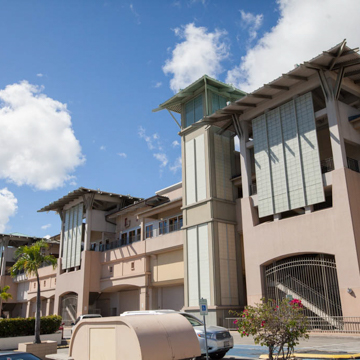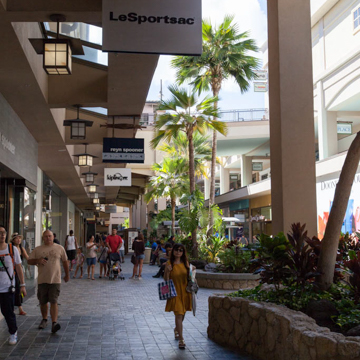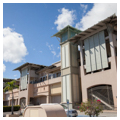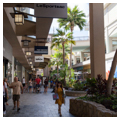When its second phase was completed in 1966, Ala Moana Center was the largest shopping center under one roof in the United States. Sitting on a fifty-six-acre parcel, the center boasted 155 stores, 1.5 million square feet of store space, and parking for 8,000 cars. This merchandising complex included an adjoining twenty-four-story office building, the Ala Moana Tower, capped by La Ronde, one of the world's earliest revolving restaurants to crown a commercial building. The restaurant seated 162 diners and rotated around a static central core.
Ala Moana Tower (1961) was Honolulu's first office tower higher than seven stories. When its facade was updated in 2000, the aluminum sunscreens were removed. In addition, the shopping center has undergone a number of facelifts, yet continues to retain its open character, as well as its congenial central stage and flowing mall-level water concourse. The arrival of Neiman Marcus in 1998 brought new prestige to the center. It also provided the critical mass to justify construction of a third level, which opened in 1999, expanding the number of shops to 230. With its present 2.1 million square feet of retail space, the mall remains among the top fifteen malls in the nation in terms of retail size.
The size of Ala Moana Center is not its only distinction. From the start, lavish plantings have graced its outdoor spaces. Coconut palms growing up through specially designed light wells and the monkeypod trees planted along Ala Moana Boulevard date from the 1960s. In conjunction with the third-level construction, the mall's landscaping was revamped by PBR Hawaii to incorporate more native plants, including hapuu tree ferns, ilima, kou, taro, banana, ohia, kukui, koa, and breadfruit. As one moves from Macy's to Sears, the plantings shift from coastal to mountain varieties. The center was also one of the first public spaces in Hawaii to be adorned with modern sculpture. Many of these works have not withstood the test of time; however, Bumpei Akaji's Manu Lewalani has found a home nestled among the plantings on the mall level, and Edward Brownlee's 1966 two-ton, bronze, freeform sculpture, originally designed for children to climb, is now embedded in stone and concrete on the mall level's mauka side. George Tsutakawa's fifteen-foot-high bronze fountain with waterfalls stands next to an equally enduring techno-thrill of 1966, the “trav-o-lator,” which smoothly transports people to and from the coral level.
At the time Ala Moana Center was built, Seattle-based architect John Graham Jr. (1908–1991) was well known as a designer of retail malls. His design of Northgate (1950) in Seattle is considered a prototype for postwar suburban shopping malls. The experience his office gained with the La Ronde restaurant allowed them to move forward with the design and construction of Seattle's Space Needle (1962).






















